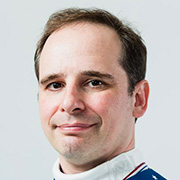DesignHammer had the opportunity to participate in and sponsor the third annual Thrive Conference, presented by the Raleigh chapter of AIGA (the American Institute of Graphic Arts). Over 250 artists, designers, brand experts, exhibitors, sponsors and more attended the event at The Fruit, a unique event space in Durham, NC, on February 29, 2020.
As a Thrive sponsor, DesignHammer aided the eco-friendliness of the conference by providing some cool, reusable Nalgene-esque water bottles for attendees. We chose to provide folks with reusable containers to encourage environmental consciousness. It was our intention to provide attendees with a reusable container that would encourage environmental consciousness not only during the conference but also in their personal lives; and for our donation to serve as a symbolic memory of the conference.
Several DesignHammer staff attended the event and have offered their insights and thoughts below.

Informative and Insightful
Thrive 2020 was full of inspiration delivered from top-tier creatives in their respective fields. The two major themes I took away from the event were:
- The importance of community (first three speakers).
- How pursuing paths of personal value and interests can lead to professional success (final three speakers).
Hugh Weber started off the day with an inspirational look at the impact people have in their inner circles of influence and also how those people impact them in return. He emphasized that being discontented in the status quo can be a major impetus to achieving great things.
Sadie Redwing encouraged the audience to adopt a greater sensitivity and a sense of community with native tribal groups, taking time to properly understand ethnic symbols and showing support for the native peoples (their population contains a disproportionately low number of individuals involved in creative fields).
Mike Hill emphasized the importance of employing Aristotle’s strategy of ethos, pathos, and logos when approaching any issue. He said that doing so will inherently broaden one’s understanding and empathy with the other party and give clarity to issues that may be unclear otherwise.
The Hellcats explained how they leveraged their common and complementary interests and backgrounds to develop a successful niche retail shop.
Rob Zilla discussed the importance of “doing what you love” and demonstrated how pursuing an iPad hobby and boldly presenting his work situated him as an in-demand graphic artist.
Finally, Mary Kate McDevitt articulated that prescribed/definitive paths to achieve a professional goal may not be appropriate for everyone and provided strategies to anticipate, address and overcome creative burn-out.
Creative Wisdom for the Business World
It was great to sponsor and help promote this event geared towards creatives and brand experts. As a web strategy, design, and development shop, it is always good business to keep an eye on the latest design trends, meet thought leaders and interact with potential future partners. While the more tactical talks weren’t necessarily relevant to my specific line of work, I found it impactful to listen to the journeys of these often underpaid and underappreciated creatives and learn how their work truly impacts the world.
A particularly powerful session for me was led by Hugh Weber, Chief Creative Officer for The Great Discontent. Known as a “researcher, network theorist, storyteller, community organizer, design advocate, and small-town kid,” Hugh offered thought leadership on maximizing your personal community to reach your goals. Specifically, he asked the audience to:
- Map our Relationships of Influence and learn how they impact our lives.
- Identify a great discontent in life and explore how you solve for it through actions and deeds.
As both a project manager and sales & marketing lead at DesignHammer, one of the main things I ‘sell’ to our potential customers and clients is the idea that we use web technology to solve business problems. We also try to uncover the greatest discontent within a given company. By first identifying pain points in a client’s business we can then find more effective ways to structure their website and employ complementary tools and analytics to address their unique issues. Our goal is not to simply create an elegant and flashy site (sorry creatives!), but to create a functional, useful website that actually serves a purpose and achieves the desired result. The concepts provided by Hugh Weber in his talk were very transferrable to these processes.
Art, Life, and Robots
Thrive 2020 was a great experience. While I have been a member of AIGA Raleigh, and a frequent industry conference attendee, this was my first time at Thrive. Chapter President Lenny Terenzi and his team of volunteers put on a great event. With a single speaker track and a small vendor hall, it was possible to absorb and appreciate everything the conference had to offer, unlike one might be able to at a larger event. At the same time, with a total attendance of 200–300 people, the crowd was large enough to attract some big names from the industry.
Of the sessions I attended, the standout for me was Mike Hill of mikehill.design. Mike is a creative director, concept artist, level designer, and IP consultant to the film and game industry, having contributed to some of the greatest titles including Blade Runner 2014, Game of Thrones, Call of Duty, and Horizon Zero Dawn.
What drew me into this session was its primary focus on communication, during which Hill outlined how he helped two distinguished Hollywood directors, David Fincher (Fight Club, Seven) and Tim Miller (Deadpool), pitch an unnamed animated series to Netflix. Referred to as UGA (Unnamed Graphic Anthology) the series, reminiscent of The Animatrix (2003) in that it consisted of animated shorts in different styles, though lacking the common theme of the Matrix-related works.
The brilliance of the pitch Hill developed, hailed as one of the best ever delivered to Netflix; was the depths at which he went to explain the essence of the show, relying heavily on Aristotle’s modes of persuasion: Ethos, Pathos, and Logos.
Hill also discussed how the title ‘Love, Death & Robots' was eventually attached to the green-lit project. In a story worthy of the works of Douglass Adams, Netflix hired two PR agencies as well as an AI developer to come up with a name for the series. After thousands of potential names were reviewed and discarded, one of the show’s creators pondered why they couldn’t come up with a suitable name for a series that was about “love, death, and robots”? The question seemed eerily similar and as equally funny as the creators of the supercomputer ‘Deep Thought’ asking their creation to answer the question of “life, the universe, and everything.” (The Hitchhikers Guide to the Galaxy, 1978)
If you haven’t watched yet, and have any interest in “sentient dairy products, werewolf soldiers, robots gone wild, garbage monsters, cyborg bounty hunters, alien spiders and blood-thirsty demons from hell,” look for Love Death + Robots on Netflix. One of my favorite series of recent years (yes, really) I say go ahead and “check it out.”
In all, it was a fantastic event that concluded with some great networking at the at Bull City Ciderworks after-party. DesignHammer values providing partnership to industry-relevant events like this around the Triangle area, and encourages staff to participate in life and career enriching events whenever possible.
Like what you read? Sign up below to get our monthly newsletter full of tools, trends, happenings at DesignHammer, and more.







Add new comment